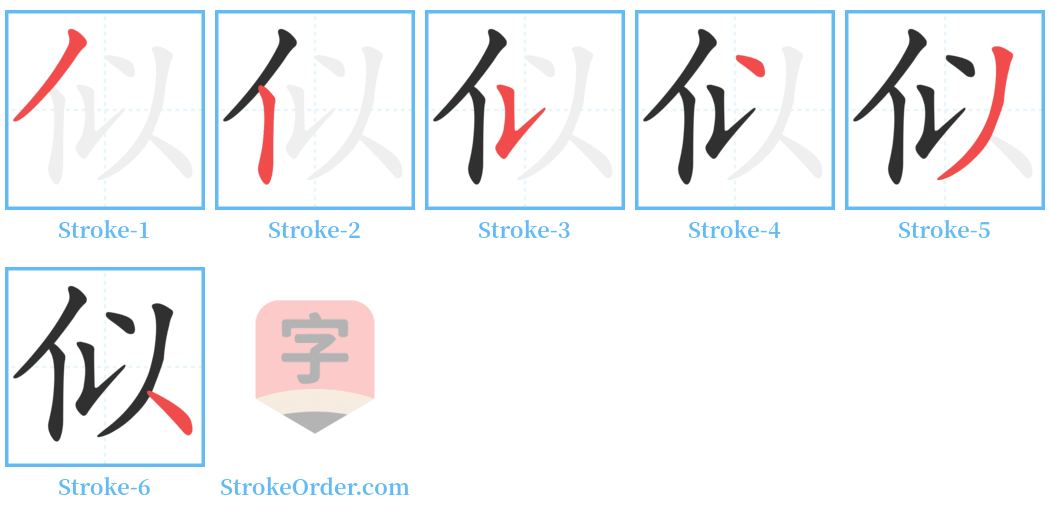似 Stroke Order
Animated Stroke Order of 似

Stroke Order Diagrams for 似

Step-by-Step Handwriting Guide for 似

Learn to Write Chinese Characters with Video Tutorials
Watch the video of writing the Chinese character "似", learn the correct stroke order (笔顺) of the character "似", and master the standard way of writing the character "似".
Free Printable Handwriting Practice with Stroke Order: 似
Printable Writing Practice Worksheet of "似" in Portrait Orientation (Tian Zi Ge)

Printable Writing Practice Worksheet of "似" in Landscape Orientation (Tian Zi Ge)

Information of 似
Pinyin
sì、 shì
Radical
亻
Strokes
6 strokes
Usage
★★★★★
Definition
to seem / to appear / similar / like / to resemble
似
sì
1. Similar, alike.
- Example: 相(xiāng )~。類~。~是而非。 (To be alike; to resemble; to appear to be right or wrong.)
2. Seems like, indicating uncertainty.
- Example: ~乎。~应如此。 (Does it seem? It should be like this.)
3. Indicates comparison, meaning more than.
- Example: 一个高~一个。 (One is taller than the other.)
4. Give.
- Example: 今日把似君,谁为不平事。 (Today I give to you, who would settle the injustice?)
5. Inherit.
- Example: 是以似之。 (This is therefore inherited.)
6. In a comparative sense, indicating a greater degree.
- Example: 今年衰似去年些。 (This year is weaker than last year.)
7. Used after verbs, indicating the action's influence extends to other places, equivalent to “with” or “to”.
- Example: 今朝别有承恩处,鹦鹉飞来说似人。 (This morning there's another place of favor, where the parrot flies and speaks like a person.)
8. In phrases like “似乎” meaning “seems” or “looks as if.”
- Example: 似乎不可信; 似若(似乎); 似是而非 (It seems unreliable; it looks like; seemingly correct yet wrong).
9. To be like something or someone in actions or appearance.
- Example: 布衾多年冷似铁,娇儿恶卧踏里裂。 (For years the cloth blanket was as cold as iron; the pampered child treads on it and tears it.)
10. To indicate similarity in a general sense.
- Example: 似的 (like); 似乎 (seems); 似然 (so it seems).
11. An additional form of the character is also used as a particle to indicate comparison, as in “似的”、“如…一般” (similar to, as if).
The character 似 can also convey several nuanced meanings depending on context, including suggestions of appearance, comparison, and inheritance or giving, showcasing the complexity and richness of Chinese language expression.
déjà vu (the experience of seeing exactly the same situation a second time) / seemingly familiar / apparently already acquainted
flowers blooming like a piece of brocade / a flourishing scene of prosperity / carpet of flowers / intellectual and artistic efflorescence
Input Method for 似
Pinyin
si4
Wubi
wnyw
Cangjie
ovio
Zhengma
nzod
Four Corner
28200
Unicode
U+4f3c
Same Pronunciation Characters